
|
||
|
Portland art blog + news + exhibition reviews + galleries + contemporary northwest art
|
||
R. Crumb and the larger Portland comix community by Mariel DeLacy “When I hear old music, its one of the few times I have a kind of looove
for humanity. You hear the best part of the soul of the common people. You know
– It’s their way of expressing their connection to eternity or whatever
you want to call it...” -Robert Crumb from Terry Zwigoff’s documentary, Crumb.
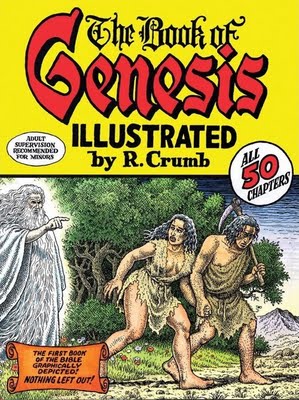 R. Crumb's The Book of Genesis at the Portland Art Museum and places that sell comic books Robert Crumb’s fans may have said the same thing about his cartoons in the 1960s and 1970s capturing the “spirit of the times.” Reverend Ivan Stang thrived off of Crumb’s common people soul expressed through his crude depictions of women, black people, or hippies that essentially evoked society’s unspoken sentiments towards American culture. "He dared to speak what, in those years, was THE UNSPEAKABLE – White man’s fear of black people, battling inside him with his innate 1960s sense that they were as human as he, or more so – was something that so self-evidently needed to be said that we readers were stunned into a sense of just how painful, and how necessary, telling the truth might be. Crumb’s depictions of blacks and women, his big-legs obsession notwithstanding, were understood by us (fellow white male artists) for what they were – far beyond racism and sexism, and in fact, violent reactions against both, using irony and horror as stylistic tools." - Ivan Stang, The Life and Times of Robert Crumb, p 48. Crumb’s style resonated with famous artists such as The Reverend Ivan Stang, Wil Eisner, and Portland's own Matt Groening; just a few of artists many who attribute their successful cartoon driven careers to Robert Crumb’s underground comix. To 1960’s America, Crumb's gritty style represented an artist who discarded the voluntarily conservative Comic Book Code laws such as, “All scenes of horror, excessive bloodshed, gory or gruesome crimes, depravity, lust, sadism, masochism shall not be permitted.” His work was out of step with the industry's self-imposed censorship, paving the way for a witty rebellion against mainstream society in cartoon form. It was a counterculture revolution that was difficult to co-opt, even by Hollywood (which has only recently become enamored with comix in a big way). 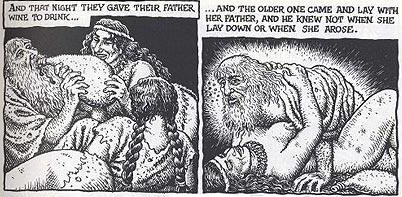 The tale of Lot in all of its gritty detail by R. Crumb However, the Portland Art Museum’s gallery tour of R. Crumb’s The Book of Genesis seemed to reveal a different world, one more accepting and honored to house Crumb than the gritty world from which his work emerged. Though it's likely that the lurid and earthy tales one finds in Genesis are what attracted Crumb to the project in the first place. In a way Crumb is finding his moral genesis by doing Genesis and the museum is interfacing with this cosmopolitan outlook through Crumb.. Thus, Crumb’s exhibit at the PAM spawned my curiosity about the modern day comix world and its response to Robert Crumb, serving as a gateway towards my growing knowledge about Portland’s bustling comic book culture – aside from R. Crumb altogether. During my tour of Portland's bustling comic book scene I was able to catch up with three comic men - Kaebel Hashitani, co-curator at Sequential Art Gallery, Matthew Clark, pencilor for DC comics and co-founder of Periscope studios, and Jason Leivian, independent bookstore owner of Floating World Comics to ask them all about their thoughts on Robert Crumb’s exhibit. Predictably, our discussions quickly deviated to a history of each man’s relationship to Portland and to the comic world in general rather than R. Crumb. I became enamored by their modern day influences, by the factors that allow them to thrive in the industry, and by those that influenced their entrance into comics in the first place. And thus, their stories. 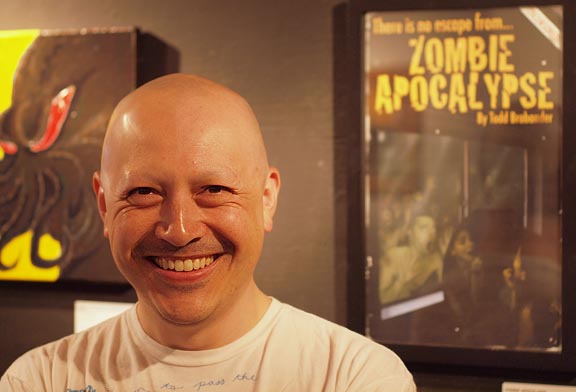
Kaebel Hashitani at Sequential Gallery (photo Jeff Jahn) Their world is pedestrian friendly – those that I spoke with all reside or work in China Town. The intimacy of the environment adds to Portland’s comic charm and commonality. Yet, I sensed Portland’s soul most vividly through Kaebel Hashitani’s gallery, Sequential Art Gallery, mainly due to the fact that the gallery is dedicated to showcasing local art. Hashitani originally came to Portland to jump-start his own penciling career. However, he opened his Gallery in 2002 and has since dedicated his work to promoting local comic artists by exhibiting their work at his gallery. Sequential Art is the first of its kind in Portland, where the “pen and paper world” as Hashitani referred to it, exit their original form as pages within a bound book and stand freely as paintings would on a wall. However, the gallery space doesn’t make each page autonomous. Hashitani and co-curator Merrick Monroe work with each artist to produce a gallery space that welds the artist’s narrative with the walls of the gallery to create one unified public presentation. “They come to me and I just say, ‘Okay! Let’s do it.’” In one case repainting the gallery doors to resemble the art on the walls to make the experience more immersive. The Sequential Gallery is where a lot of would be comic book artists make connections, find mentors and get feedback from like minded peers. Hashitani's accommodating attitude towards these artists has created a reciprocitous relationship between himself and the Portland comic community as well as with the artistic arena in general. According to Hashitani, “if the artists has a vision, Sequential is there to provide a skeletal void for them to fill.” Yet, when the artists need assistance, he and Merrick will help design a set to follow the comic’s narrative. 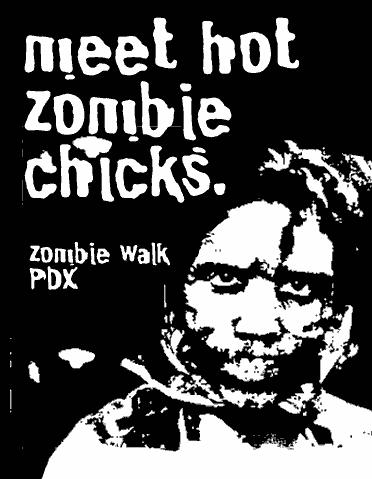 Portland's now annual Zombie Walk Once, in conjunction with a zombie art opening at the gallery, Kaebel organized a unique Portland Zombie Walk – now annual event in October, which tours the Pearl District and China Town, essentially shadowing the typical art gallery crawl. Kaebel’s gallery represents a non-traditional gallery space, different from the PAM exhibit of Robert Crumb since it is a place where comic book artists develop ideas and receive feedback at the street level. Although PAM didn’t integrate comic artists within the Portland world as Kaebel may have, he still “appreciated the Genesis being shown in the city.” Kaebel's mission caters to the comic book world. PAM is presenting a high level sample of that world to a generally less initiated audience.. Ultimately PAM's R. Crumb exhibit prompted me to glimpse Kaebel’s world. 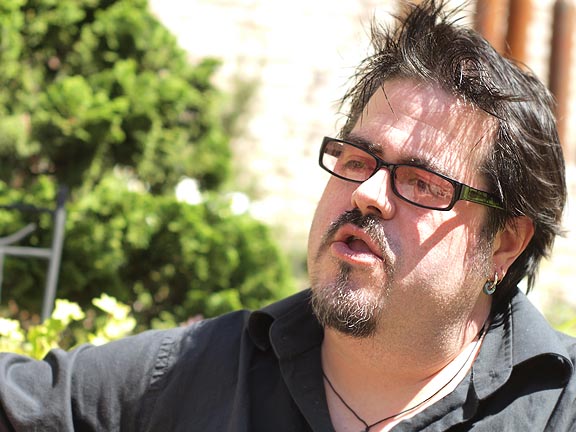 Matt Clark (photo Jeff Jahn) Just above Sequential lies the Everett Station Lofts – the homing zone of the greater majority of Portland’s comic people. Here I found Matthew Clark – Portland’s very own, high profile DC pencilor who makes his living off of his renditions of Superman and Batman, among other characters. Clark also co-founded Mercury Studios in Portland back in 2001, now commonly known as Periscope Studios. As a fellow cartoonist, Clark enjoyed the PAM exhibit’s depiction of R. Crumb’s creation process of Genesis. “I wanted to see the production sketches, the model sheets, what kind of pencil did he use, what kind of paper? – that to me is more interesting than the finished product.” Also, "The Museum did get Joe Sacco to make a big public appearance, he just doesn't do that even for the Cons." Yet, Clark works for a large (and very mainstream) company based in New York City, which, one would assume, keeps him out of touch with Portland’s comic scene. However, the geographical location of his loft is significant to this NY connection in Portland. He lives amongst the greater majority of Portland’s comic artists. We chatted on the ESL communal terrace. He has showcased his work at Sequential twice in the past, and Hashitani noted that Clark is scheduled to return. Furthermore, Clark’s love for his profession strengthens his strenuous lifestyle. When he was working at Mercury, he would take the first bus to the studio, work all day, and take the last bus home. As the studio continually expanded (and eventually became Periscope), Clark moved his office to home where he still works. His penciling takes discipline, dedication, and passion – all of which he channels into his renditions of his favorite childhood superheros for DC, which fund his career. Matt Clark is inspiring to all those who wish to make a living off of their childhood dreams. Portland has a surprisingly large number of Professionals like Clark and according to him, “Not to be morbid, but if a bomb went off in Portland the comic book industry would not recover, at least for a long time. With Dark Horse, several from DC, Joe Sacco and others there is a real talent pool here. It's a nice thought really that we have carved out lives like this in Portland.” 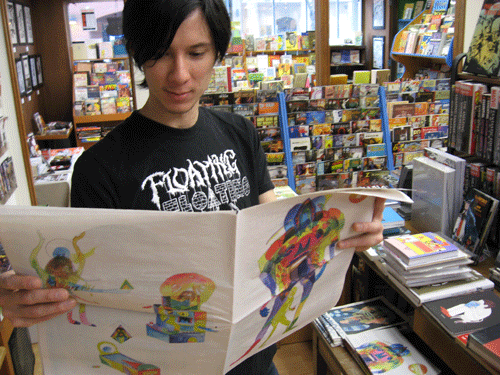
Jason at Floating World Comics (photo Arthur Smid) As I continued my walking tour of China Town’s comic world, I discovered Jason Leivian at Floating World Comics. Leivian represents a melange of the mainstream and indie comic men I interviewed. He started Floating World in 2006 to supplement Portland’s lack of comics shops housing both mainstream comics and independent zines. Aside from the store, he also utilizes his space to showcase local and international comic artists at his China Town location every First Thursday. He showed Polaroids from a local Portland photographer at the July First Thursday this summer. On the August 5th First Thursday, he brought in Canadian comics Brandon Graham and Simon Roy as well as Brian Lee O’Malley’s Scott Pilgrim to Floating World. Levian and I discussed Hollywood’s recent fascination with comics – Christopher Nolan’s Dark Knight, Edgar Wright’s Scott Pilgrim Verses the World, Hellboy, Sin City, 300, etc., and it’s affect on readership in his store. His consensus was that there really wasn’t a large spike in readership. “I would estimate that any increase we saw died down along with the hype of the movie.” This would suggest that Portland’s scene retains genuine lovers of the comic book. The industry just doesn’t seem to attract or need fringe workers. My interviews were all the more enjoyable because of that, for I felt the passion behind each line of work. Passion seems to feed passion in this town, and I doubt the rest of Portland’s world deviates far from China Town’s standard for comic workers. My only fear is that some of these artists would flee the city if our cost of living increased. Clark and Hashitani both attributed Portland’s low COL as their number one reason for moving to the city in the first place. However, if Portland, Oregon’s cheap digs provide us with the second largest collection of comic book artists in the world then I hope our residential conditions remain fixed at the status quo. They live near one another, they work near one another, they integrate their work with each other, and they were all willing to share their tight-knit world with an outsider such as myself. If R. Crumb finds the soul from the common man out of old Jazz, I found a nice Portland soul from my walk around Portland’s Comicville in China Town. Mariel DeLacy is PORT's 2010 Summer intern and is currently spending a semester in Europe. Posted by Guest on September 04, 2010 at 13:53 | Comments (0) Comments Post a comment Thanks for signing in, . Now you can comment. (sign out)
(If you haven't left a comment here before, you may need to be approved by
the site owner before your comment will appear. Until then, it won't appear
on the entry. Thanks for waiting.)
|
| s p o n s o r s |
 |
 |
 |
 |
 |
 |
 |
 |
 |
 |
 |
 |
 |
 |
 |
 |

|
Site Design: Jennifer Armbrust | • | Site Development: Philippe Blanc & Katherine Bovee | |

